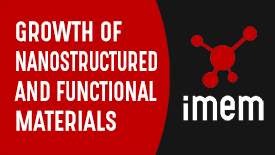Most of metal oxides are functional materials with chemical and physical properties that are useful and interesting for different kinds of application.
When they are obtained in form of bi- or mono-dimensional nanostructures, new and peculiar properties add up to the traditional ones, thanks to the high surface/volume ratio, the increased surface reactivity, the impact of their size on the electrical and heat transport, the occurrence of quantum effects.
Many of these properties can also be controlled, and sometimes “tuned as desired”, through the modification of their size, their “doping level” or the coupling with other nanostructures.
IMEM has been working on the synthesis and the study of these nanostructures for almost 20 years, with the goal to use exploit them in different fields, such as gas and volatile organics sensing, photo-catalysis for pollutants reduction, biomedical diagnostics, photovoltaics, optoelectronics and fundamental physics study.
Here below you can find a few more information about:
- SnO2, In2O3, Ga2O3, CuO and PbO nanowires
- ZnO nanotetrapods and other nanostructures
- modification of nanostructure properties by coupling with other nanomaterials
- integration of ZnO nanostructures in conventional materials to make them "smart"
SnO2, In2O3, Ga2O3, CuO and PbO nanowires
Nanowires of different metal oxides, such as for example tin oxide (SnO2), indium oxide (In2O3), gallium oxide (Ga2O3), copper oxide (CuO), or lead oxide (PbO), have been obtained setting-up and optimizing a special vapour phase synthesis process. This process uses only oxygen and vapours of the corresponding metal in order to produce high-purity nanostructures.
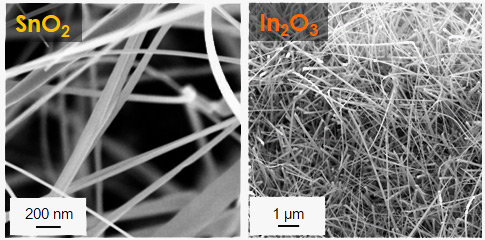
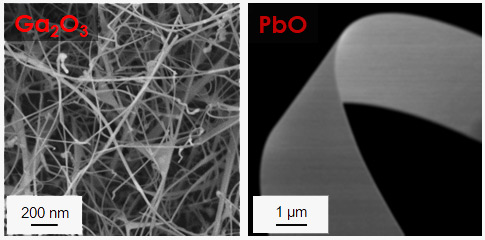
SEM images of tin oxide (SnO2), indium oxide (In2O3), gallium oxide (Ga2O3), and lead oxide (PbO) nanowires that were produced at IMEM
SnO2, In2O3, and CuO nanowires are of great interest for the production of gas sensors, CuO nanowires are also used in photocatalysis and water-splitting applications, Ga2O3 can be employed as UV radiation detectors, while PbO nanowires are promising for the production of miniature X ray detectors.
ZnO nanotetrapods and other nanostructures
Zinc oxide (ZnO) is one of the so called “multifunctional” materials, owing several chemical and physical properties that can be exploited (sometimes even simultaneously) to play different “functions” (semiconductor, piezoelectric, chemoreristor, UV emitter, transparent conductor, etc).
This great versatility, when combined with the large number of possible nanostructures that are available for this material, makes ZnO an extraordinary tool to create new kind of devices.
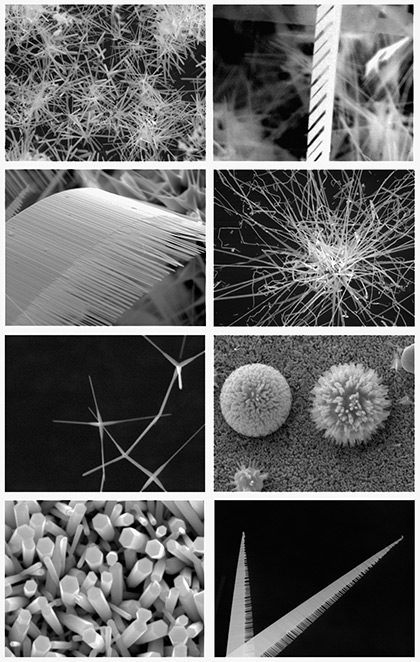
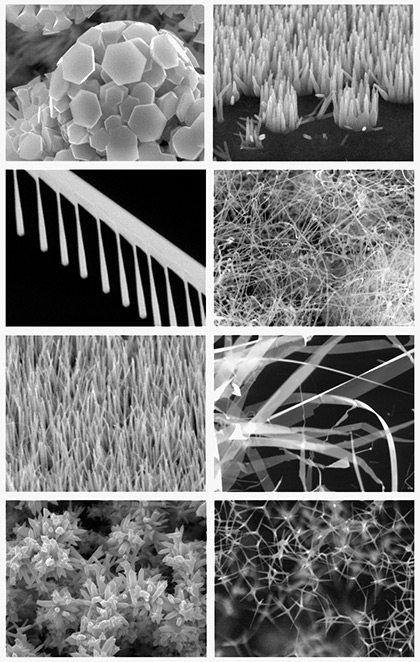
SEM images of different kind of ZnO nanostructures that were produced at IMEM
Thanks to a vapour phase synthesis process, where the reaction of oxygen and metallic Zn vapour occurred together with the right nucleation conditions, it has been possible to create a large number of ZnO nanostructures with different morphologies. In particular, this process was optimized to produce homogeneously three of these nanostructures, with no other kind of morphology: nanowires, nanorods and nanotetrapods.
Nanotetrapods, that can be produced in large amounts, have been widely employed to make gas sensor devices.
Nanorods, instead, can be grown also by a solution based chemical process at much lower temperature (<110°C). This process is affected by lower purity, if compared to the vapour phase one, but allowed us to homogenously coat very wide areas with ZnO nanorods.
Modification of nanostructure properties by coupling with other nanomaterials
The noteworthy properties of metal oxide nanostructures can be further extended if they are combined with those of other nanomaterials, coupled on their surface. In this way it is possible to add new properties to the nanostructured oxides (for example magnetic properties, visible light adsorption, catalysed reactivity with specific chemical compounds) or modify the existing ones.
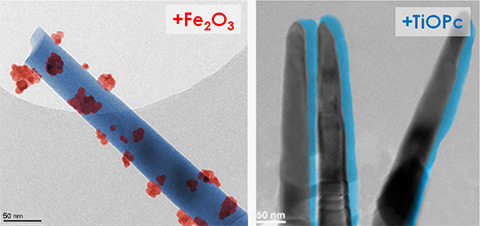
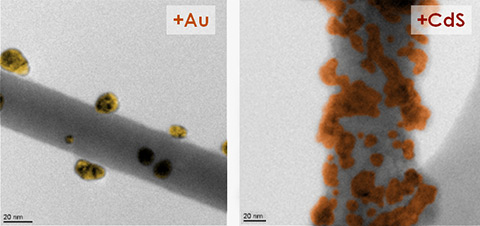
SEM images of ZnO nanostructures coupled with different nanomaterials: magnetic iron oxide (Fe2O3), an organic semiconductor (titanyl phthalocyanine - TiOPc), gold (Au), a sulfur-based semiconductor (cadmium sulphide – CdS).
This principle has been applied manly to ZnO nanostructures in order to obtain, for example, a photo-catayst to remove pollution from water and can be recollected by a magnet thanks to the addition of magnetic nanoparticles.
In a similar way, the optimization of different coupling techniques led to the fabrication of hybrid photovoltaic cells, substrates for SERS analysis of cells and other organic compounds, gas sensors with higher selectivity towards specific compounds.
Integration of ZnO nanostructures in conventional materials to make them “smart”
ZnO nanorods were deposited on different conventional materials, such as carbon fibers, textile fibers, or metal wires, thanks to a solution-based chemical synthesis that allowed the nanostructures to grow at relatively low temperature.
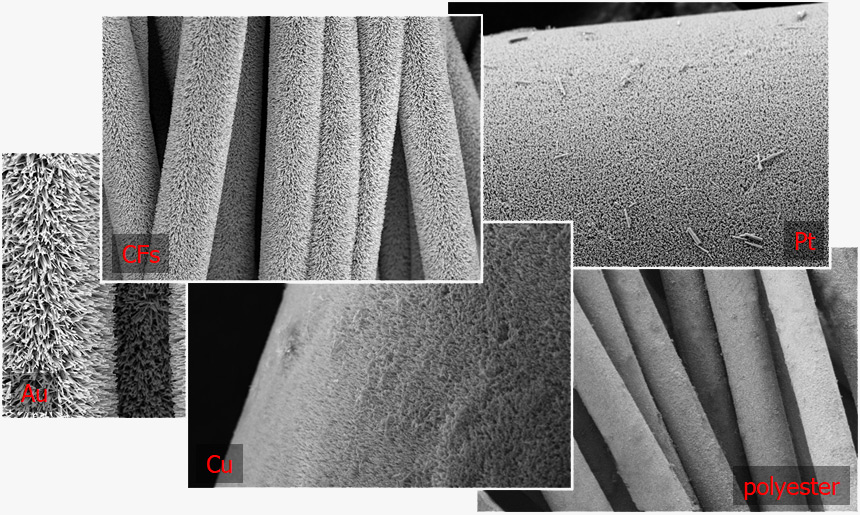
This kind of process is the base for the nanotechnology we developed to integrate different devices in conventional materials to make them “smart”.
For example, the addition of ZnO nanorods on carbon fibers allowed us to create “smart” composite materials that are able to measure the stress/strain or vibration they are subject to.
Publications
• D. Calestani, M. Zha, G. Salviati, L. Lazzarini, L. Zanotti, E. Comini, G.Sberveglieri, "Nucleation and growth of SnO2 nanowires”, Journal of Crystal Growth, 275 (2005), e2083 [link]
• L. Zanotti, M. Zha, D. Calestani, E. Comini, G. Sberveglieri, "Growth of tin oxide nanocrystals”, Crystal Research and Technology, 40 (2005), 932-936 [link]
• D. Calestani, L. Lazzarini, G. Salviati, M. Zha, "Morphological, structural and optical study of quasi-1D SnO2 nanowires and nanobelts”, Crystal Research and Technology, 40 (2005), 937-941 [link]
• E. Comini, G. Faglia, G. Sberveglieri, D. Calestani, L. Zanotti, M. Zha, "Tin oxide nanobelts electrical and sensing properties”, Sensors and Actuators B, 111-112 (2005), 2-6 [link]
• D. Calestani, M. Zha, A. Zappettini, L. Lazzarini, G. Salviati, L. Zanotti, G. Sberveglieri, "Structural and optical study of SnO2 nanobelts and nanowires”, Materials Science and Engineering C, 25 (2005), 625-630 [link]
• M. Mazzera, M. Zha, D. Calestani, A. Zappettini, L. Lazzarini, G. Salviati, L. Zanotti, "Low-temperature In2O3 nanowire luminescence properties as a function of oxidizing thermal treatments”, Nanotechnology, 18 (2007), 355707 [link]
• D. Calestani, M. Zha, A. Zappettini, L. Lazzarini, L. Zanotti, "In-catalyzed growth of high-purity indium oxide nanowires”, Chemical Physics Letters, 445 (2007), 251-254 [link]
• M. Zha, D. Calestani, A. Zappettini, R. Mosca, M. Mazzera, L. Lazzarini, L. Zanotti, "Large-area self-catalysed and selective growth of ZnO nanowires", Nanotechnology, 19 (2008), 325603 [link]
• M.C. Carotta, A. Cervi, V. di Natale, S. Gherardi, A. Giberti, V. Guidi, D. Puzzovio, B. Vendemiati, G. Martinelli, M. Sacerdoti, D. Calestani, A. Zappettini, M. Zha, L. Zanotti, "ZnO gas sensors: a comparison between nanoparticles and nanotetrapods-based thick films", Sensors and Actuators B, 137 (2009), 164-169 [link]
• L. Lazzarini, G. Salviati, F. Fabbri, M. Zha, D. Calestani, A. Zappettini, T. Sekiguchi, B. Dierre, "Unpredicted Nucleation of Extended Zinc Blende Phases in Wurtzite ZnO Nanotetrapod Arms”, ACS NANO, 3 (2009), 3158-3164 [link]
• D. Calestani, M. Zha, R. Mosca, A. Zappettini, M.C. Carotta, V. Di Natale, L. Zanotti, "Growth of ZnO tetrapods for nanostructure-based gas sensors”, Sensors and Actuators B, 144 (2010), 472–478 [link]
• L. Zanotti, D. Calestani, M. Villani, M. Zha, A. Zappettini, C. Paorici, "Vapour-phase growth, purification and large-area deposition of ZnO tetrapod nanostructures”, Crystal Research and Technology, 45 (2010), 667-671 [link]
• D. Calestani, M. Zha, L. Zanotti, M. Villani, A. Zappettini, "Low temperature thermal evaporation growth of aligned ZnO nanorods on ZnO film: a growth mechanism promoted by Zn nanoclusters on polar surfaces”, Crystengcomm, 15 (2011), 1707-1711. [link]
• C. De Zorzi, G. Rossetto, D. Calestani, M. Zha, A. Zappettini, L. Lazzarini, M. Villani, N. El Habra, L. Zanotti, "Pd/PdO functionalization of SnO2 nanowires and ZnO nanotetrapods”, Crystal Research and Technology, 46 (2011), 847-851. [link]
• 10.1016/j.snb.2017.01.109D. Calestani, R. Mosca, M. Zanichelli, M. Villani, A. Zappettini, "Aldehyde detection by ZnO tetrapod-based gas sensors”, Journal of Materials Chemistry, 21 (2011), 15532-15536. [link]
• M. Villani, D. Calestani, L. Lazzarini, L. Zanotti, R. Mosca, A. Zappettini, "Extended functionality of ZnO nanotetrapods by solution-based coupling with CdS nanoparticles”, Journal of Materials Chemistry, 22 (2012), 5694-5699. [link]
• N. Coppedè, D. Calestani, M. Villani, M. Nardi, L. Lazzarini, A. Zappettini, S. Iannotta, "Directionally selective sensitization of ZnO nanorods by TiOPc: A novel approach to functionalized nanosystems”, Journal of Physical Chemistry C, 116 (2012), 8223-8229. [link]
• N. Coppedè, M. Villani, R. Mosca, S. Iannotta, A. Zappettini, D. Calestani, "Low Temperature Sensing Properties of a Nano Hybrid Material Based on ZnO Nanotetrapods and Titanyl Phthalocyanine”, Sensors, 13(2013), 3445-3453. [link]
• G. Benassi, N. Zambelli, M. Villani, D. Calestani, M. Pavesi, A. Zappettini, L. Zanotti, C. Paorici, "Oriented orthorhombic Lead Oxide film grown by vapour phase deposition for X-ray detector applications”, Crystal Research and Technology, 48 (2013), 245-250. [link]
• M. Villani, T. Rimoldi, D. Calestani, L. Lazzarini, V. Chiesi, F. Casoli, F. Albertini, A. Zappettini, "Composite multifunctional nanostructures based on ZnO tetrapods and superparamagnetic Fe3O4 nanoparticles”, Nanotechnology, 24 (2013), 135601. [link]
• D. Calestani, S. C. Dhanabalan, M. Villani, L. Lazzarini, A. Zappettini, "InZnO nanorods obtained via zinc vapour phase deposition on liquid indium seeded substrates”, CrystEngComm, 16 (2014), 1696-1701. [link]
• F. Fabbri, M. Villani, A. Catellani, A. Calzolari, G. Cicero, D. Calestani, G. Calestani, A. Zappettini, B. Dierre, T. Sekiguchi, G. Salviati, "Zn vacancy induced green luminescence on non-polar surfaces in ZnO nanostructures”, Scientific Reports, 4 (2014), 5158. [link]
• M. Villani, A. B. Alabi, N. Coppedè, D. Calestani, L. Lazzarini, A. Zappettini, "Facile synthesis of hierarchical CuO nanostructures with enhanced photocatalytic activity”, Crystal Research and Technology, 49 (2014), 594-598. [link]
• S. C. Dhanabalan, J. P. Garcia, D. Calestani, F. Pattini, F. Bissoli, M. Villani, S. Rampino, A. Zappettini, "Controllable vapor phase growth of vertically aligned ZnO nanorods on TCO/Glass substrates”, Crystal Research and Technology, 49 (2014), 558-563. [link]
• D. Calestani, M. Villani, R. Mosca, L. Lazzarini, N. Coppedè, S. C. Dhanabalan, A. Zappettini, "Selective response inversion to NO2 and acetic acid in ZnO and CdS nanocomposite gas sensor”, Nanotechnology, 25 (2014), 365502. [link]
• S. Picciolini, N. Castagnetti, R. Vanna, D. Mehn, M. Bedoni, F. Gramatica, M. Villani, D. Calestani, M. Pavesi, L. Lazzarini, A. Zappettini, C. Morasso, "Branched gold nanoparticles on ZnO 3D architecture as biomedical SERS sensors”, RSC Advances, 2015 (5), 93644-93651. [link]
• G. Bertoni, F. Fabbri, M. Villani, L. Lazzarini, S. Turner, G. Van Tendeloo, D. Calestani, S. Gradecak, A. Zappettini, G. Salviati, "Nanoscale mapping of plasmon and exciton in ZnO tetrapods coupled with Au nanoparticles”, Scientific Reports, 6 (2016), 19168. [link]
• M. Villani, D. Delmonte, M. Culiolo, D. Calestani, N. Coppedè, M. Solzi, L. Marchini, R. Bercella, A. Zappettini, "Turning carbon fiber into a stress-sensitive composite material”, Journal of Materials Chemistry A, 4 (2016), 10486-10492. [link]
• S.L. Marasso, A. Tommasi, D. Perrone, M. Cocuzza, R. Mosca, M. Villani, A. Zappettini, D. Calestani, "A new method to integrate ZnO nano-tetrapods on MEMS micro-hotplates for large scale gas sensor production”, Nanotechnology, 27 (2016), 385503. [link]
• D. Calestani, A.B. Alabi, N. Coppedè, M. Villani, L. Lazzarini, F. Fabbri, G. Salviati, A. Zappettini, "Growth and characterization of β-Ga2O3 nanowires obtained on not-catalyzed and Au/Pt catalyzed substrates”, Journal of Crystal Growth, 457 (2017), 255-261. [link]
• D. Calestani, M. Villani, M. Culiolo, D. Delmonte, N. Coppedè, A. Zappettini, "Smart composites materials: A new idea to add gas-sensing properties to commercial carbon-fibers by functionalization with ZnO nanowires”, Sensors & Actuators: B. Chemical, 245 (2017) 166-170. [link]
• D. Calestani, M. Culiolo, M. Villani, D. Delmonte, M. Solzi, T. Y. Kim, S. W. Kim, L. Marchini, A. Zappettini, "Functionalization of carbon fiber tows with ZnO nanorods for stress sensor integration in smart composite materials”, Nanotechnology, 29 (2018) 335501. [link]








